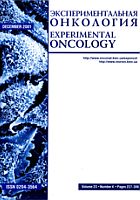
Бази даних
Наукова періодика України - результати пошуку
 |
Для швидкої роботи та реалізації всіх функціональних можливостей пошукової системи використовуйте браузер "Mozilla Firefox" |
|
|
Повнотекстовий пошук
| Знайдено в інших БД: | Реферативна база даних (3) |
Список видань за алфавітом назв: Авторський покажчик Покажчик назв публікацій  |
Пошуковий запит: (<.>A=Muzalov I$<.>) | |||
|
Загальна кількість знайдених документів : 2 Представлено документи з 1 до 2 |
|||
| 1. | 
Mikhailenko V. M. Exogenous nitric oxide potentiate DNA damage and alter DNA repair in cells exposed to ionising radiation [Електронний ресурс] / V. M. Mikhailenko, I. I. Muzalov // Experimental oncology. - 2013. - Vol. 35, № 4. - С. 318-324. - Режим доступу: http://nbuv.gov.ua/UJRN/EOL_2013_35_4_17 The aim of this study was to investigate impact of exogenous nitric oxide (NO) on generation of different types of DNA damages, their transformation, and specificity of DNA repair in cells treated with ionizing radiation (IR). Levels of single-strand and double-strand breaks assessed in peripheral blood lymphocytes (PBL) isolated from healthy humans and treated in vitro with NO donor - S-nitrosoglutathione (GSNO) and IR. The rate of DNA repair estimated after 30 and 60 min of PBL treatment. The visualization and measuring the number of prompt and delayed DNA damages, including strand breaks, apurinic and thermolabile sites performed with single-cell gel electrophoresis. IR caused dose-dependent generation of single strand breaks (SSBs), double strand breaks (DSBs), and heat-labile sites (HLS) in cell DNA. However, particularly destructive was combined treatment IR with GSNO as NO donor that leads to a significant increase of DNA damage and a dose-dependent inhibition of the DNA repair rate. Obtained data proofs the ability of NO to inhibit fast and slow stages of SSBs, DSBs, and HLS repair resulting in significant growth of genotoxic effect. DNA breaks generation from HLS is able to affect DSBs yields especially in cells with altered DNA repair. The process of DNA repair of delayed DSBs formed from HLS was quite different from removal of DNA damages occurring immediately after treatment and was characterized by IR dose dependent inhibition of DNA repair. Conclusion: high level of DNA strand breaks, that are generated after the combined treatment with NO and IR, are accumulated for quite a long time after exposure due to altered DNA repair, indicating the development of genetic instability and increase of carcinogenic risk for organism exposed to combination of harmful environmental factors. | ||
| 2. | 
Muzalov I. I. Peculiarities of DNA damage caused by exogenous nitric oxide combined with fractionated low dose ionizing radiation in normal and tumor cells [Електронний ресурс] / I. I. Muzalov, V. M. Mikhailenko // Experimental oncology. - 2015. - Vol. 37, № 1. - С. 40-43. - Режим доступу: http://nbuv.gov.ua/UJRN/EOL_2015_37_1_9 The aim of this study was to investigate the reaction of normal and tumor cells to genotoxic effect of widespread environmental factors - exogenous nitric oxides and ionizing radiation. The animals were treated with NO (125 mg/m<^>3 | ||
 |
| Відділ наукової організації електронних інформаційних ресурсів |
 Пам`ятка користувача Пам`ятка користувача |